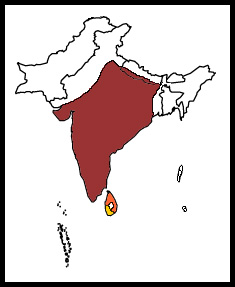
Photo by dineshagg
Ranthambore, Rajasthan India, May 2006
- Dicrurus caerulescens
Identification
24cm. A small drongo.
- Black upperparts
- Slaty grey throat and breast
- White belly and vent:
- Relatively short, moderately forked tail
Sexes alike, females are slightly smaller. Juveniles are dark brown above, brown on throat and breast and have some white barring on breast.
Similar species
Juveniles of Black Drongo, Ashy Drongo and Crow-billed Drongo may have considerable white on vent but these areas look scalier, not solid white.
Distribution
| Found in large parts of India, southern Nepal and Sri Lanka. Widespread but uncommon in large parts of its range. | |
| Legend • D. c. caerulescens; year-round |
Taxonomy
Subspecies
Three subspecies recognized[1]:
- D. c. caerulescens (Indian White-bellied Drongo) on the Indian Peninsula from Haryana and eastern Gujarat east along lower slopes of the Himalayas to south Nepal and to west Bengal and central Orissa.
- D. c. insularis (Ceylon White-bellied Drongo) in north and southeast Sri Lanka
- D. c. leucopygialis (White-vented Drongo) in southwest Sri Lanka
Habitat
Open forest and well-wooded habitats. Occurs up to 2000m in the Himalayas, up to 1500m in South India.
Behaviour
Diet
Feeds mostly on insects, takes sometimes small birds. Occasionally pirates food from other birds.
Perches upright on a branch or treetrop and flies out from there with agility, snapping up prey in bill or claws.
Breeding
Breeding season March to June in most of its range, insularis breeds from February to June, leucopygialis from March to May. The nest is a large and bulky cup made of grass and twigs. It's placed 3 - 9m above the ground in a tree. Lays 2 - 3 eggs, 2 - 4 in Sri Lanka.
Movements
A resident species. In India some seasonal local and altitudinal movements, eg in Gujarat.
References
- Clements, J. F., T. S. Schulenberg, M. J. Iliff, D. Roberson, T. A. Fredericks, B. L. Sullivan, and C. L. Wood. 2014. The eBird/Clements checklist of birds of the world: Version 6.9., with updates to August 2014. Downloaded from http://www.birds.cornell.edu/clementschecklist/download/
- Del Hoyo, J, A Elliott, and D Christie, eds. 2009. Handbook of the Birds of the World. Volume 14: Bush-shrikes to Old World Sparrows. Barcelona: Lynx Edicions. ISBN 978-8496553507
- Rasmussen, PC and JC Anderton. 2005. Birds of South Asia: The Ripley Guide. Barcelona: Lynx Edicions. ISBN 978-8487334672
Recommended Citation
- BirdForum Opus contributors. (2024) White-bellied Drongo. In: BirdForum, the forum for wild birds and birding. Retrieved 20 April 2024 from https://www.birdforum.net/opus/White-bellied_Drongo
External Links
GSearch checked for 2020 platform.1





